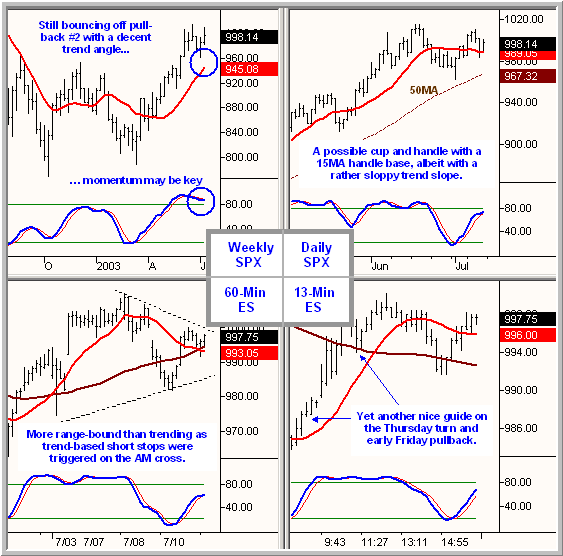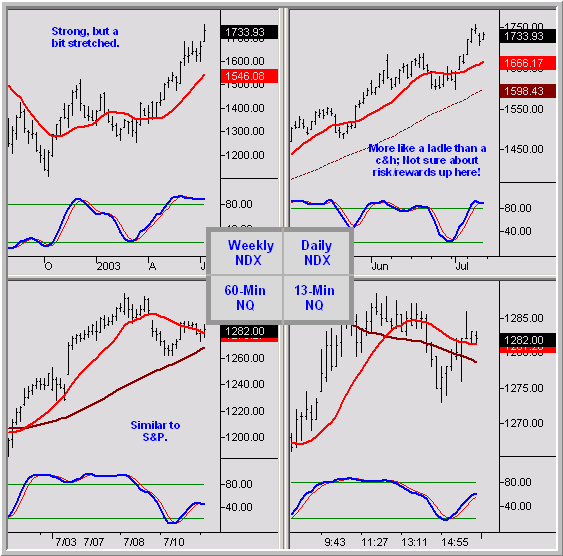Two Attributes Of Successful Traders
Now that we’re on our weekly
schedule, I wanted to welcome all of the non-intraday traders to the
segment. Based on my mail, it appears that the weekly piece is reaching out to
an additional segment of readers and traders that don’t normally check in
intraday. Welcome!
As we enter another summer weekend, the major indices continue their
recent theme of 1990s déjà vu as
pullbacks in major uptrends continue to hold and the Nasdaq continues to play
pace car. Bulls are delighted, the Red Sox are on fire, and life — if long the
market or a long-suffering Sox fan — is good.
Now for the public service sanity check. Today is July 11 — not even the
All-Star break — and all traders will care about on Monday morning where the
market is likely to go from here, whether it be over the next five minutes for
scalpers or the next two months for longer term players. I don’t know about
you, but it seems the press has gotten a bit deafening and the bandwagon feels a
bit heavy … and I’m not talking about the Sox. I say this not because I’m
bullish or bearish … as a short-term intraday trader, my goal is to be both
bullish and bearish at times intraday and to be in cash every night … it’s just
hard not to hear the roar even with earplugs on, thus the comment.
Yet the market is the one that should do the talking, so I’ll let the charts do
today’s talking on the technical front, and then respond to a recent trader
question.
S&P 500

Nasdaq

Moving Avg
Legend: 15MA
Larger Timeframe 15MA
See https://www.donmillertrading.com
for Setups and Methodologies
Charts © 2003 Tradestation
Attributes of
Successful Traders
Someone recently asked me what I considered to be the two most important
attributes of successful traders. To those new to the column, it may be
worth mentioning that I approach successful trading from the perspective that it
is a learned skill involving a mix of psychology and technicals which few
can craft … versus solely relying on a technical “system” that doesn’t possess
human judgment. After thinking it over for a few minutes, including looking
back at my own screw-ups and successes, I responded rather quickly with “perseverance
and confidence“. In fact, I’ll go a great deal farther than calling them
attributes and refer to them as the two most important assets of one’s
trading business.
Let’s put it this way — let’s say I was visited by the trading “genie” (OK,
admittedly corny, but bear with me) with the option of choosing one of the
following four sets of possible business assets — with the rule that choosing
one would preclude use of all others:
-
A free lifetime subscription to the most advanced charting
platform, news feeds, best industry chat rooms, and top market service
newsletters;
-
Free lifetime access to a system which in five years will have
generated signals that were correct 80% of the time;
-
Three years worth of guaranteed targeted trading income (keeping
our “asset” theme, let’s consider this a lump-sum amount discounted to today’s
dollars);
-
Strong personal confidence in one’s ability, including the ability
to persevere over the long term (for business purists, we’ll place this in the
intangible asset category).
And while the answer at this end is clear (D — as in “duhhh”) and you
may think you’ve just stumbled across a “Trading for Kindergarteners”
column, the majority of newer folks pursuing this dog-eat-dog business
continue to be focused on pursuing A & B, or would choose C in the spirit of
wanting the fish and not the rod. Such an observation is far from opinion, for
it reflects recent and recurring emails and discussions within the industry.
Let’s look a bit closer at the first three options.
-
Best tools. The first problem with this set of assets is that it
includes components where someone is often telling you what to do (the last
two items), without knowing your tolerance for risk, level of trading
maturity, and most importantly, how you’re wired. I could go on talking about
all of the after-the-fact malarkey as in some of the recent bullish (or is it
an anagram with one additional letter) news pieces that are telling you the we
finally have enough confirmation of a bull turn … well, I guess I just did.
With respect to news feeds, three words … don’t need ’em … ever (ok, that’s
four). And a state-of-the-art charting platform without the confidence in how
to use it? Might as well hand me the dentist drill and a mirror.
-
Guaranteed Probability Patterns. In reality this term is of course
- Lump sum windfall. OK, three years is great, but what happens after
that? Remember, the rule was that the choice of one would preclude use of all
others, including confidence.
an oxymoron, but let’s have some fun with it in the spirit of that “First
Edition” show a few years ago that provided tomorrow’s newspaper today. 80%
probability may be tempting, what about that one trade, hour, or day where you
undo a month’s worth of work? Without confidence, it can and will happen and
can inflict far greater damage on one’s lasting confidence than one’s
pocketbook … been there, done that.
Â
Don’t get me wrong, good platforms are important and neither confidence nor the
ability to anticipate probabilistic patterns will develop without some
foundational guidance in terms of education. And quality market analysis by a
third party can be helpful in providing a bit of objectivity if one is locked
into an inappropriate personal bias. Yet I’ll go to my grave believing with
time tested (as in black and blue) conviction that the end game for any trader
worth his/her weight has to be developing a strong sense of personal confidence
and perseverance.
So how does one get there? For newer traders, an initial step is to work your
tail off to settle on a single method of trading, for familiarity breeds
confidence. One can begin by surveying the various trading styles and methods
out there with the goal — and here’s where many folks lose it —
of ultimately settling on one
style that fits your style and comfort level.Â
There are many outstanding educational and market advisory services out there …
just scan through the abundance of information on this site. Larry Connors and
his team deserve a great deal of credit for compiling all of the information on
this site, and there are many styles taught by quality traders from which to
pick.
Yet many folks never get past what I’ll call “method sampling”, even during what
should be considered their prime trading years. Baseball fans of my era may
remember Dwight Evans of the Red Sox back in the 80’s who one year seemed to
come to every at-bat with a different batting stance. When he finally settled
on one, his career was resurrected briefly and he put up astounding power
numbers for two years.
When I was asked to consider teaching traders several years ago, I ultimately
agreed to do so with one personal caveat, and that was with the primary
objective of helping to develop self-sufficient traders. For having
sifted through the industry wheat (rare) and chaff (frequent) and incurring my
own experiences of pain and pleasure, I believed such a goal would be in the
best long-term interest of emerging traders and not the teacher/trader,
or as is the predominant case, teacher/non-trader.
And while I strongly believe in the consistent use of probabilistic market
patterns, several options of which are presented in the
E-Mini video and
simulation
courses, my goal remains to help develop skilled traders who can stand on
their own two feet and make strong decisions with conviction based on their
preferred style before the masses. And style based on individual
circumstances has to be considered.
For example, do you prefer reversal or trend continuation trades? How about
ranges? Want to trade the indices? Great, which trading vehicle do you prefer:
the leveraged and competitive E-Mini futures market or the less chaotic ETFs?Â
Like the multiple timeframe support/resistance concept to guide your trades?Â
Fine, are you wired to scalp intraday using a three-minute/13-minute combination
or do you prefer to trade over multiple days using an hourly/daily combo? For
just as the chances that a Red Sox/Cubs World Series is in the works, no two
traders are likely to execute the same sequence of trades using any similar
pattern or method … so why force yourself into a single method?
With respect to perseverance, some folks come to this business with it as the
result of having to deal with past business failures, severe illnesses, or other
trying circumstances that have tested both mettle and faith, while others have
to pay their dues in this business to gain it. And while those of us who teach
work like heck to try to minimize the experience “dues” paying component that
comes as perseverance is nurtured by sharing our own lessons learned, there’s
really no way around that fact the dues should be expected to be paid and will
likely reflect your best long-term investment — period, exclamation point.
Let me close by responding to a recent mailbag item:
We love your methodology, and have learned so much from the course … thank you
for putting this course out there. It has been a life changing event for us, and
has improved our trading profits by 60%. And, you’re pretty funny too! — N.N.
My response to N.N. is that while I and others may provide a seed, nothing grows
successfully without the gardener’s sweat, toil, and perseverance, and only you
can do that. Well done.
Good Trading and Have a Great
Weekend!
